Deciding on the best self-propelled lawn mower isn’t as easy as it used to be. Do you need commercial or residential quality? Do you want to use gas or batteries for power? How much grass do you need to cut? Are you a mulcher or a bagger?
Having tested dozens of the best walk-behind lawn mowers from entry-level residential to the top professional models, we got our Pro team together to choose our top mowers in a range of scenarios.
Best Self-Propelled Lawn Mower Overall
Honda HRC216 Series Commercial Lawn Mowers
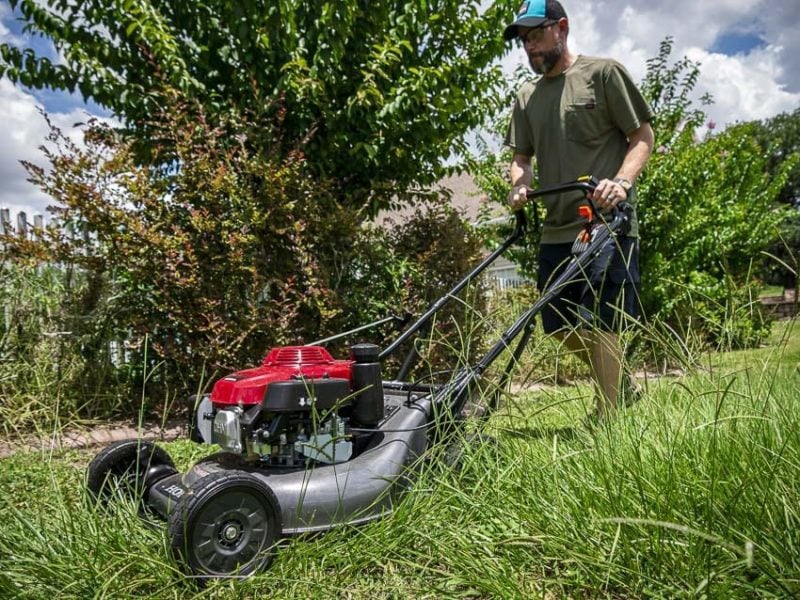
Start with a Honda GXV160 engine, tell the design team to build the best lawn mower they can think of, and you end up with the Honda HRC216 series. The flagship model is the HRC216HXA. Highlights include a hydrostatic transmission, RotoStop system that lets you take your hands off without turning off the engine, MicroCut twin blades, and more. It’s not just a bunch of hype, either. This mower is powerful and built to a level that stands up to legitimate commercial and possibly even battlefield use.
If you want to save a little money and the Blade Stop feature doesn’t feel like a requirement to you, check out the HRC216HDA mower which drops the price to $1,379.
Price: $1379 – $1489
Best Residential Self-Propelled Gas Lawn Mower
As our top overall pick, Honda’s HRC216 series also ranks highest as the best gas self-propelled lawn mower. While we let it bask in victory, check out our top pick for Prosumer mowers that bridge the gap between residential and Pro.
Honda HRX217 Series
If you don’t need a full commercial build, but you’re still looking for a self-propelled lawn mower built better than entry-level models, we recommend Honda’s HRX217 series. While any of the five mowers in the line are a great pick, the HRX217HYA and HRX217HZA models are on the top of our list.
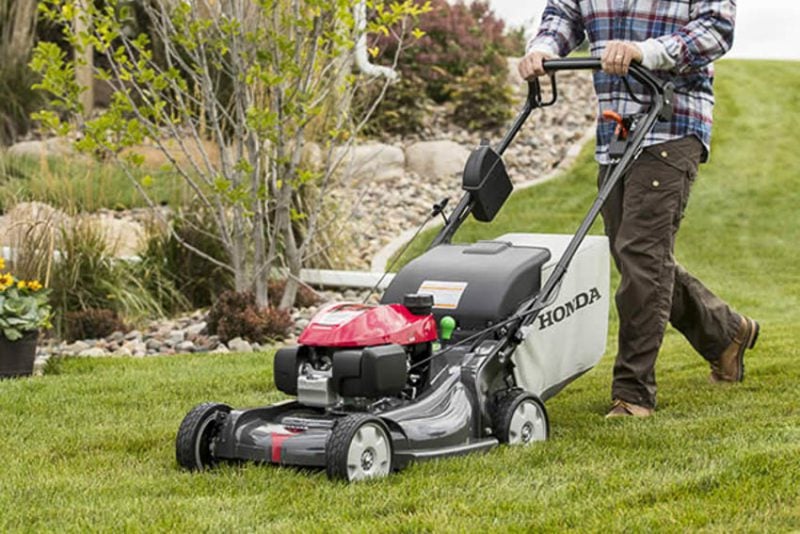
They use a strong Honda GCV200 engine and combine it with a hydrostatic self-propelled drive that offers cruise control to dial in the speed you want. Stacked twin blades give these mowers excellent cutting results and RotoStop lets you take your hands off the mower without shutting down the engine.
Honda’s VersaMow design lets you shift between bagging, mulching, side discharge, and leaf shredding. The best part is you don’t need to keep track of plugs or other accessories—it’s all built into the mower!
Between the HYA and HZA models, the only difference is the HZA has an electric start. Feel free to go for it, but we find Honda engines reliable enough that they start on the first or second pull years into their service life.
Price: $969 – $1079 (Other HRX217 models start at $769)
If you like the reliability of Honda engines, but you have a lower budget, check out Honda’s HRN216 series.
Best Self-Propelled Electric Lawn Mower
Just a few years ago, if you wanted to find the best battery-powered lawn mower, you could only find residential models. Now, there’s an emerging class of professional-grade options and we have picks for both Pros and homeowners.
Professional Pick: Milwaukee M18 Fuel 21-Inch Self-Propelled Lawn Mower
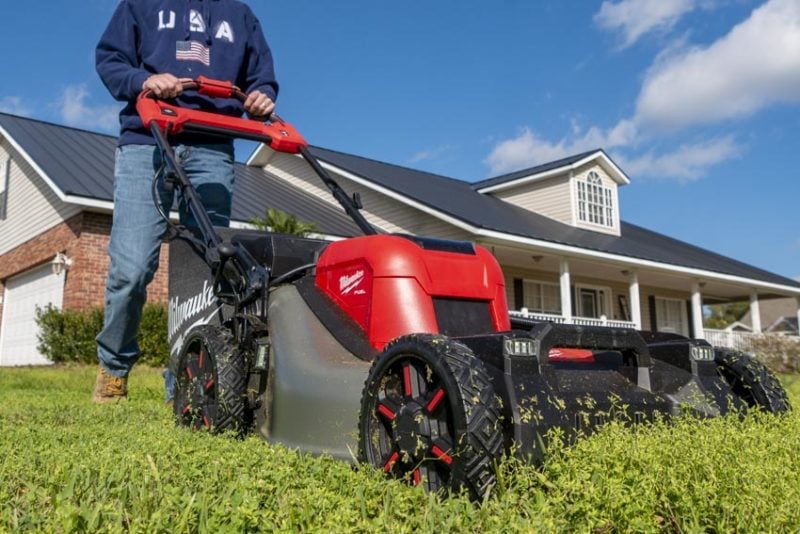
There aren’t many true commercial self-propelled lawn mowers with lithium-ion power sources. Milwaukee launched their effort in 2022 with a monstrous 10 ft-lbs of torque that tops what you typically see from a 200cc gas engine. It’s more than just muscle, though. Its blade and deck combine to handle mulching and bagging better than most.
As you roll into fall, the mower’s high-lift mode keeps the blades at 3300 RPM to help pull those lightweight leaves and clean up your lawn. Other features include 180° LED lighting, LED battery indicators facing you, variable speed thumb bar (in addition to the speed wheel), a durable build, and much more.
Price: $999.00 with two 12.0Ah batteries and dual-port rapid charger
Also Consider:
Makita 18V X2 Self-Propelled Lawn Mower XML08 (Buy at Acme Tools: $719 bare, $849 with 4 batteries and dual-port rapid charger)
Heads up: Makita has a new ConnectX system with a 1200Wh battery to run each of its tools, including a new commercial lawn mower. Keep your eyes open for more information once we’re able to test it.
Greenworks Commercial 25-Inch Self-Propelled Lawn Mower (Buy at Greenworks Commercial: Starts at $649 bare)
Residential Pick: EGO 56V Select Cut XP 21-inch Self-Propelled Mower
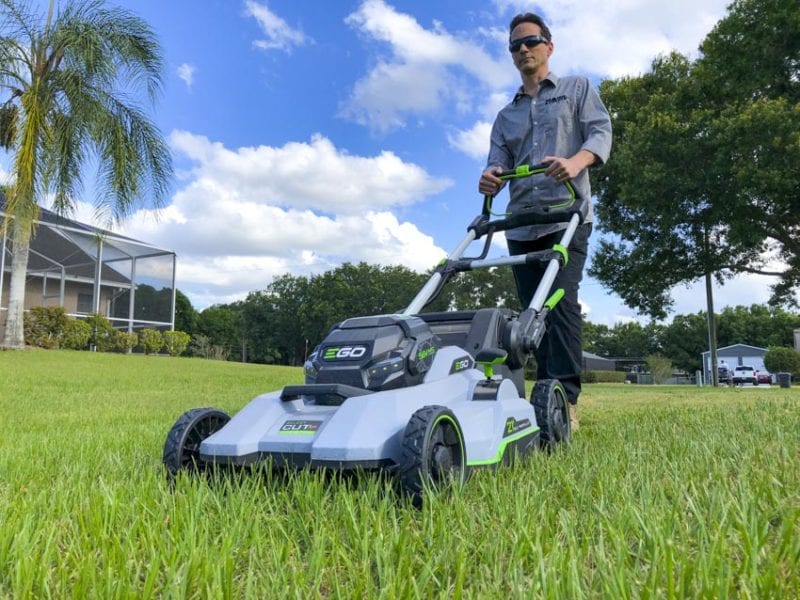
The original EGO Select Cut mower made waves with its stacked-blade system. Choosing between better mulching or better runtime, you can select what your priority is. Then EGO went and made it even better by increasing the power with the Select Cut XP. Instead of choosing between the outstanding cut quality of the Select Cut and the higher torque of the Peak Power model, you get the best of both worlds.
Price: $549 bare, $799 with 10.0Ah battery and charger
Also Consider:
Ryobi 40V HP Brushless CrossCut Self-Propelled Lawn Mower (Buy at The Home Depot: $639 with two 6.0Ah batteries and charger)
Best Large Walk-Behind Lawn Mower
Toro TimeMaster 30-inch Personal Pace Mower
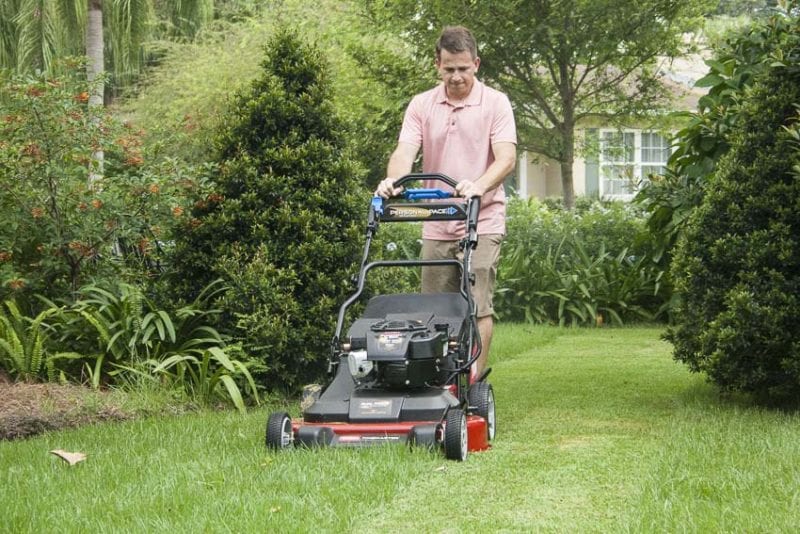
With 10 ft-lbs of torque delivered from its Briggs & Stratton 223cc engine, the 30-inch Toro TimeMaster is our pick as the best large walk-behind lawn mower. Not only does it deliver big power to turn its time-saving 30-inch blade, but it also features Toro’s Personal Pace self-propelled drive and Spin-Stop that lets you stop the blade without shutting off the mower.
It all adds up to big time savings on larger lawns. Grab model 21200 if you want an electric start or the 21199 if you don’t mind a recoil start and want to save $100.
Price: $1399.99 (21199), $1499.99 (20200)
Best Budget Self-Propelled Lawn Mower
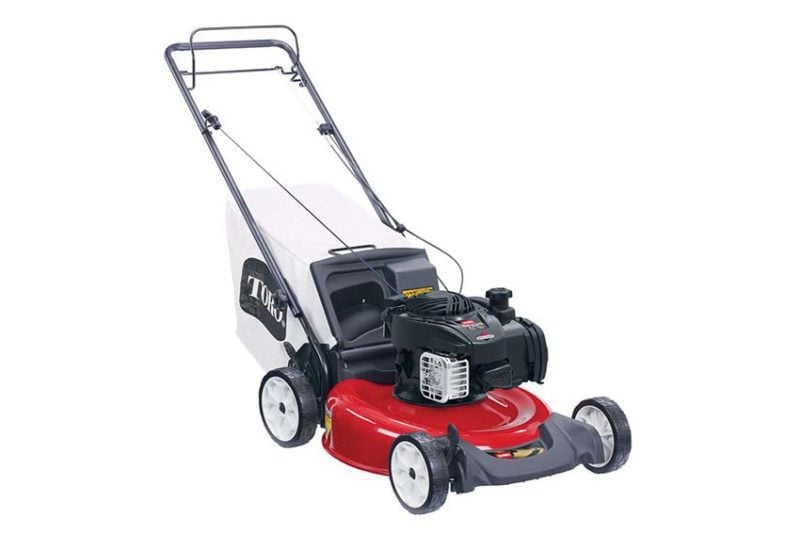
Toro’s 21-inch Recycler (21352) offers an excellent value for budget-minded homeowners. It’s a Made in the USA rear-wheel drive system powered by a Briggs & Stratton 140cc engine. It comes ready to mulch, bag, or side discharge and you don’t have to worry about changing the oil. Just check the levels and add more when it’s necessary.
Price: $359
Best Self-Propelled Lawn Mower Brand
No one in the self-propelled lawn mower market dominates like Honda. Their engines enjoy a reputation for quality and durability every other manufacturer is shooting for, and their mowers are simply outstanding.
They typically run at a premium, though. Both Honda mowers and Honda-powered mowers are more expensive than similar designs from other brands.
That opens the door for Toro. There are a lot of Toro models we recommend for good reason and hit a wide range from budget-friendly homeowner mowers to commercial zero turns. It’s one of the best-selling brands of walk-behind mowers.
Getting hard sales figures is tough to come by, and it’s always possible we missed the mark. However, we see more Honda and Toro walk-behind mowers on commercial trailers and residential lawns than any other brand.
Best Self-Propelled Lawn Mower for Bagging
You don’t have to ditch your current self-propelled lawn mower and buy a whole new one to improve your bagging efficiency. In most cases, adding a high-lift blade to your current mower will make a significant difference. With the exception of electric mowers, you don’t need to worry too much about matching the brand making the blade, but you do need to match the arbor style and the length. The package should tell you which brands it is compatible with.
If you’re still in the market for a new mower, higher RPMs make for better airflow and bagging. Check mowers with a 160cc or higher engine and compare the top blade speeds. You can always swap blades, but you can’t change the speed.
Pro Tip: If you have a 2-point or 4-point deck height adjustment, set the front wheels of your mower one notch higher than the rear to improve bagging.
Best Self-Propelled Mulching Lawn Mower
Similar to a high-lift blade for bagging, you can improve your mulching efficiency with a mulching-specific blade. These usually have additional cutting edges that cut the clippings more times before they drop back into the grass. Keeping the blade sharp ensures you get the best mulching results every time you mow.
If you’re in the market for a new mower, look for a 160cc or higher engine to give you the torque you need to keep your blade speed high in thicker grass. Remember, you can always add a mulching blade, but you can’t make up for an underpowered engine.
Pro Tip: You get the best mulching results if you’re only taking an inch or two off the top of your grass, so make sure you stay on top of lawn maintenance during the peak cutting season.
Best Self-Propelled Lawn Mower | More Priorities
Best Commercial Walk-Behind Mower: YBravo Gen II 25-inch Commercial Mower
Honda still gets our vote for the best commercial walk-behind mower. If you’re interested in something other than Honda, we have another great choice.
After running into issues with other commercial walk-behind mowers, we turned to YBravo 25-inch commercial mower to take care of a 3-acre soggy field that our ZTs only bogged down in. Its Kawasaki 180cc engine kept the blade turning where others simply stalled.
When it’s time to move out of the radio station swamp and you’re going for a more professional look, its cut quality is excellent as well. Available in a 21-inch and the 25-inch model we tested, Ybravo is worth your serious consideration.
If you have a Bad Boy dealer closer to you, check out the same model sold under the Bad Boy brand name.
Price: $1299 (25-inch model). Find a dealer online.
Best Rear-Wheel Drive Self-Propelled Lawn Mower for Hills: Honda HRN216 Series 21-inch Self-Propelled Mower
We already mentioned the Honda HRN216 series and we’re bringing it up again. Representing our choice as the best rear-wheel-drive self-propelled lawnmower, the HRN216VYA takes care of business better than most with the rear-wheel advantages of better traction and straighter lines.
It also comes with Honda’s RotoStop system that lets you stop the blade without stopping the engine. Now you can open gates, move debris, empty the bag, or traverse non-grass areas without worrying about the blades turning or having to restart the engine.
Price: $509
Best All-Wheel Drive Self-Propelled Lawn Mower: Toro 22-inch Personal Pace All-Wheel Drive Mower 21472
AWD mowers are what you turn to for work on slopes and uneven terrain where it’s possible to have a wheel or two lose traction. For the best all-wheel drive self-propelled lawn mower, we like the Toro 21472 Personal Pace model.
Its 22-inch deck is on the larger size of standard mowers and the Personal Pace system is easy to work with once you get used to it. If you switch between mulching and bagging, the mower’s lever system is super simple.
Packing plenty of power with its 163cc Briggs & Stratton engine, it’s not so much that it destroys the competition. It’s that its performance is excellent and the innovations are genuinely helpful while keeping its price in check.
Price: $479
Best Lawn Mower Buying Guide | What We Look For
Gas vs Battery
Gas power still wins the day when you’re highest priorities are keeping your purchase price down and your power level high. With advancements in battery and motor technology, the OPE world is shifting towards battery power, though. It’s cleaner and quieter to run and requires less maintenance.
However, you have to look at premium models to get true gas power, and runtime can be a limiting factor. It’s also less likely you have a service center nearby that can get you back up and running quickly if there’s a problem.
If your lawn is a 1/4-acre or less, there are a lot of battery-powered options available. Once you get beyond that size, you need to consider how many batteries you’ll need and legitimate options really start to thin out once you hit 1/2 an acre. With larger lawns, newer battery-powered zero turn mowers are a legitimate option.
Take a deeper look at the comparison between gas and battery power in this article.
Commercial vs Residential
This might be better titled “professional vs homeowner” considering there are both commercial and residential professional crews. Regardless, commercial mowers are built with better components and commercial engines, creating a machine that is built to last for years of high-hour daily use.
If you’re a homeowner mowing once a week or so, a good residential mower can still last for 5 or 10 years (or more) if you take care of it. It just uses components and engine designs better fit for occasional use.
Engine Size and Cutting Power
If you stay on top of your mowing and cut quality isn’t a high priority, an engine as small as 140cc is likely fine.
Move up to the 160cc–180cc class for better performance when the grass is thicker and taller, or when you want to make sure you get excellent mulching, bagging, and/or clean cuts. The greater power improves lift and is less likely to bog down in thick patches.
When you’re looking at deck sizes beyond 22 inches, you should start looking for engines in the 180cc–200cc range (or higher) to ensure it can keep the RPMs high while it’s cutting such a large swath.
Cut Quality
We look for three major components of cut quality: evenness, mulching size, and bagging efficiency.
Evenness is pretty straightforward. When we’re testing, we look for grass blades that weren’t cut and indications that there wasn’t enough lift to clip all of the blades at the same level.
When mulching, smaller clippings are better since they drop down closer to the base of the remaining grass. We also look to see if a mower is prone to leaving trails and clumps.
For bagging, it’s all about how much grass is collected, if the chute tends to clog while we’re cutting, and how much grass is deposited back to the ground.
Noise Level
One of the major benefits of battery-powered mowers is the lower noise levels compared to gas, but that doesn’t mean gas mowers have to be obnoxious. We expect higher levels than battery-powered models and that is typically the case.
When we test noise levels, we measure from our operator’s ear to get an idea of what the person using the mower should expect. Even though some mowers are quieter than others, we still recommend hearing protection when you’re using a gas model.
Fuel Efficiency
How efficient gas mowers use fuel has a very direct effect on your wallet, especially when you’re mowing every day as a Pro.
Fuel efficiency testing is more than just a runtime calculation. The cutting swath of a mower comes into play, especially on those 25 and 30-inch models. With larger lawns, it’s possible to get more cutting done per gallon of gas with an engine that uses more gas per hour.
Deck Size
21 or 22 inches is pretty standard for most mowers. Jumping up to a 25-inch or 30-inch mower may seem tempting, but it’s not for everyone.
If your lawn is a 1/4-acre or less, the time you gain with a larger deck might not mean a whole lot of time savings. Where you really gain some time is on lawns that are a 1/2-acre or more.
Keep in mind, larger deck-size mowers are heavier. When you have to mow wet or soggy areas, the weight can work against you.
Steel vs Plastic (Poly) Deck
The vast majority of gas mowers have steel decks while battery-powered models have a much higher percentage of plastic poly decks.
Those poly plastic decks are tougher than they look, but they probably won’t hold up as well as steel in the long run. It’s still highly unlikely that you’ll wear through one before it’s time to replace the mower, though.
However, there’s a whole lot more design flexibility that comes with poly decks, and engineers can do some amazing things to help with airflow that directly affects cut quality along with bagging and mulching efficiency.
Deck Height
Here in Florida, we have a lot of St. Augustine grass that we cut at 3 1/2 inches, so we prefer a mower that has at least a 4-inch maximum deck height.
Depending on what species of grass you have, you might be able to get away with a lower height, but 4 inches is a good all-around benchmark.
On the low end, most of us aren’t cutting golf course greens (you’d use a reel mower for that, anyway), so the minimum deck height usually isn’t an issue.
However, if you use a blade that dethatches or scalps for maintenance or re-seeding, you might want to make sure the deck height gets low enough—typically 1 1/2 inches or less.
Height Adjustment
Single-point height adjustments are the easiest since you can raise or lower the deck with just one lever. It’s common on battery-powered lawn mowers, but not so much on their heavier gas counterparts.
Part of that is because the single-point mechanisms tend to introduce additional flex into the system and the weight of a gas mower puts more strain on the mechanism. So while we generally prefer single-point, we understand why gas mowers may opt away from them.
Pro Tip: Set the front wheels one notch higher than the rear wheels to improve bagging efficiency on 4-point or 2-point adjustable mowers.
Adjustment Levels
If you’re really OCD, more height adjustments mean more precise cutting. Realistically, most of us are going to find a good height on any mower as long as it hits the maximum and minimum heights we mow at.
Setting the Speed
The type of speed adjustment your self-propelled lawn mower has can make or break your experience. There are pull levers, thumb push levers, full push bars (Toro’s Personal Pace), and iterations on those.
Try it at the dealer before you buy it. If you hate working the mechanism for a couple of minutes, imagine what it’s going to feel like after 30 minutes or an hour.
Front-Wheel Drive, Rear-Wheel Drive, or All-Wheel Drive?
Front-wheel drive lawn mowers are typically the least expensive and work well for even terrain. They also help you turn the easiest since you lift up the drive wheels as you make your turns.
Rear-wheel drive mowers add some cost but create better traction on hills and slopes. They’re particularly good at pushing the mower’s weight uphill where front-wheel drives start to lose traction as they try to pull the weight.
All-wheel drive mowers are the most expensive and generally do the best job on hills, slopes, and uneven terrain. On particularly bumpy areas where it’s likely one or more wheels will lose traction, it’s the best bet.
Wheel Size
Larger wheels tend to handle bumps and uneven terrain better than smaller wheels according to manufacturers. However, it’s a claim that Consumer Reports says isn’t really the case.
Electric Start
If you’ve used a gas engine, there’s a good chance you’ve worn out your arm pulling the cord to start it. There’s no doubt that having an electric start on your mower can take away a lot of the frustration.
It won’t make up for poor maintenance, though. A well-maintained mower starts easily on the first or second pull. That begs the question as to whether the electric start is worth an extra hundred dollars.
It’s totally up to you, but if it’s in the budget, we want it.
Mulch, Bag, or Side/Rear Discharge?
Most quality mowers are 3-in-1, meaning you can bag, mulch, or side/rear discharge. Less expensive models often only provide options for bagging and mulching. Which one you choose depends on what type of grass you have, how fast it grows, and your personal preference.
In central Florida where St. Augustine, Zoysia, and Bahia dominate our landscapes, the summer heat and rains make our grass grow incredibly fast. Most of us mulch out of necessity since we almost need a dumpster for the volume of clippings we create.
Handle Positions
Most lawn mowers have 3 handle positions you can set. For tall guys like me or average-height guys like Clint, it helps you find a more comfortable grip. Some mowers opt for 2, or sometimes just 1 handle position.
Value
Value is more than just price. We take a broad look at the performance and features compared to the price to determine the value of each mower.
Why You Can Trust Pro Tool Reviews
Ever check out a “review” site and you can’t tell if they actually tested the tools or if they’re just “recommending” the Amazon top sellers?
That’s not us. We only recommend what we’d actually use, even if we don’t earn a commission from it. It’s all about giving you a legitimate recommendation and our honest opinion of each product.
We’ve been in business since 2008 covering tools, writing reviews, and reporting on industry news in the construction, automotive, and lawn care industries. Our Pro reviewers work in the trades and have the skills and experience to know whether tools can perform well in the field.
Each year, we bring in and review more than 250 individual products. Our team will put our hands on hundreds of additional tools at media events and trade shows throughout the year.
We consult with innovators in the technology and design of tools to gain a broader grasp of where these products fit and how they work.
We work with more than two dozen professional contractors around the United States who review products for us on real job sites and consult with us on testing methods, categories, and weighting.
We’ll provide more than 500 pieces of new content this year absolutely free for our readers—including objective evaluations of individual tools and products.
The end result is information you can trust because of the editorial, scientific, and real-world professional experience we collectively utilize each and every time we pick up and test a tool.

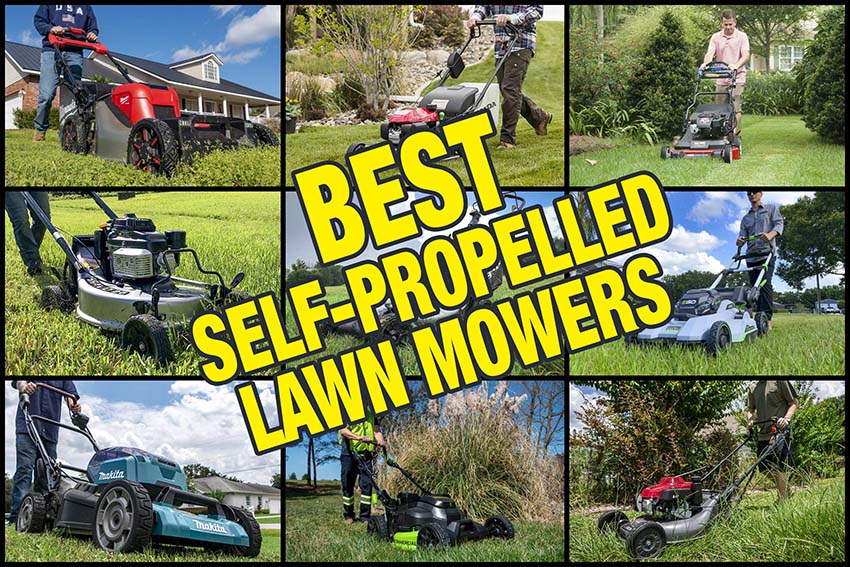
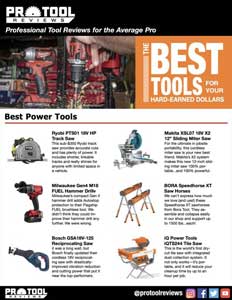


I have a Honda 217 hrx self-propelled lawn mower best lawn mower I have ever had lawn boys and Toros are now just cheap imitations of their previous Great lawn mowers. The Honda starts first pull after being in storage for the winter the versa drive is great I sent it to Max to go up a hill and then dial it down to go down the hill mowing this fantastic mulching is great if I didn’t mulch I would have six to seven bags of grass clippings but when I do bag the bag holds more than any other… Read more »
you may want to do better research before claming a milwaukee-m18-fuel” as a pro mower its not even close to being commercial, the actual commerical 21 is the toro 22282 60 volt hd, also exmark is releasing theres.
milwakuee may want to be commerical but your comparing apples to oranges.
Great reviews. I don’t understand, though, how these are 2021 reviews, but I can’t find a source to buy any of the ones I’m interested in. (the Acme Tool links don’t work– they say the item is no longer available for sale.)
The Cub Cadet SC900 can no longer be purchased 😕
This is a fabulous article but I *wish* a print version was available. I printed out the existing pages but can’t make heads or tails of them!